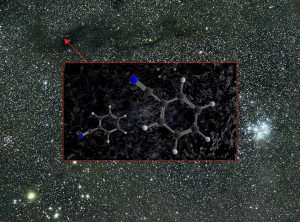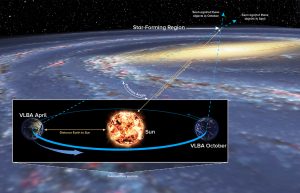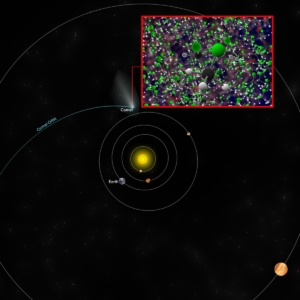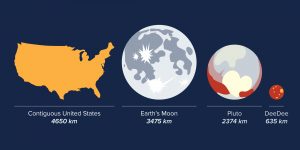Astronomers using the Green Bank Telescope have made the first definitive interstellar detection of benzonitrile, an intriguing organic molecule that helps to chemically link simple carbon-based molecules and truly massive ones known as polycyclic aromatic hydrocarbons. This discovery is a vital clue in a 30-year-old mystery: identifying the source of a faint infrared glow that permeates the Milky Way and other galaxies. The science team, led by chemist Brett McGuire at the National Radio Astronomy Observatory in Charlottesville, Virginia, detected this molecule’s telltale radio signature coming from a nearby star-forming nebula known as the Taurus Molecular Cloud 1, which is about 430 light-years from Earth.


The Parallax Technique
The parallax technique determines distance by measuring the angle of apparent shift in an object’s position, as seen from opposite sides of Earth’s orbit around the Sun. Using this method, astronomers were able to directly measure the distance to a region on the far side of our Milky Way Galaxy, past the Galaxy’s center.

Methyl Chloride in Comet 67P/C-G
Approximate location of comet 67P/C-G when the Rosetta space probe discovered traces of methyl chloride — the same molecule detected by ALMA around the IRAS 16293-2422 star-forming region — along with other molecules.

VLBA Global Locations
Artist’s conception of the Very Long Baseline Array (VLBA), a continent-wide radio telescope system. The VLBA is an interferometer consisting of 10 identical antennas on transcontinental baselines up to 8000 km (Mauna Kea, Hawaii to St. Croix, Virgin Islands). The VLBA is controlled remotely from the Science Operations Center in Socorro, New Mexico. Each VLBA station consists of a 25 m antenna and an adjacent control building. The received signals are amplified, digitized, and recorded on fast, high capacity recorders. The recorded data are sent from the individual VLBA stations to the correlator in Socorro.

DeeDee’s Orbit
Orbits of objects in our solar system, showing the current location of the planetary body ‘DeeDee’.

Size of DeeDee
Size comparisons of objects in our solar system, including the recently discovered planetary body ‘DeeDee.’





